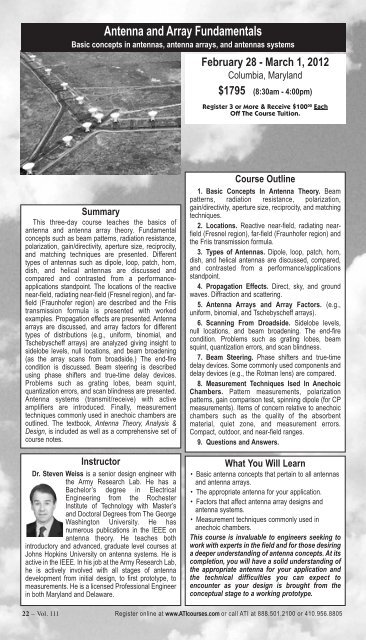Download - Applied Technology Institute
Download - Applied Technology Institute
Download - Applied Technology Institute
Create successful ePaper yourself
Turn your PDF publications into a flip-book with our unique Google optimized e-Paper software.
Antenna and Array Fundamentals<br />
Basic concepts in antennas, antenna arrays, and antennas systems<br />
February 28 - March 1, 2012<br />
Columbia, Maryland<br />
$1795 (8:30am - 4:00pm)<br />
Register 3 or More & Receive $100 00 Each<br />
Off The Course Tuition.<br />
Summary<br />
This three-day course teaches the basics of<br />
antenna and antenna array theory. Fundamental<br />
concepts such as beam patterns, radiation resistance,<br />
polarization, gain/directivity, aperture size, reciprocity,<br />
and matching techniques are presented. Different<br />
types of antennas such as dipole, loop, patch, horn,<br />
dish, and helical antennas are discussed and<br />
compared and contrasted from a performanceapplications<br />
standpoint. The locations of the reactive<br />
near-field, radiating near-field (Fresnel region), and farfield<br />
(Fraunhofer region) are described and the Friis<br />
transmission formula is presented with worked<br />
examples. Propagation effects are presented. Antenna<br />
arrays are discussed, and array factors for different<br />
types of distributions (e.g., uniform, binomial, and<br />
Tschebyscheff arrays) are analyzed giving insight to<br />
sidelobe levels, null locations, and beam broadening<br />
(as the array scans from broadside.) The end-fire<br />
condition is discussed. Beam steering is described<br />
using phase shifters and true-time delay devices.<br />
Problems such as grating lobes, beam squint,<br />
quantization errors, and scan blindness are presented.<br />
Antenna systems (transmit/receive) with active<br />
amplifiers are introduced. Finally, measurement<br />
techniques commonly used in anechoic chambers are<br />
outlined. The textbook, Antenna Theory, Analysis &<br />
Design, is included as well as a comprehensive set of<br />
course notes.<br />
Instructor<br />
Dr. Steven Weiss is a senior design engineer with<br />
the Army Research Lab. He has a<br />
Bachelor’s degree in Electrical<br />
Engineering from the Rochester<br />
<strong>Institute</strong> of <strong>Technology</strong> with Master’s<br />
and Doctoral Degrees from The George<br />
Washington University. He has<br />
numerous publications in the IEEE on<br />
antenna theory. He teaches both<br />
introductory and advanced, graduate level courses at<br />
Johns Hopkins University on antenna systems. He is<br />
active in the IEEE. In his job at the Army Research Lab,<br />
he is actively involved with all stages of antenna<br />
development from initial design, to first prototype, to<br />
measurements. He is a licensed Professional Engineer<br />
in both Maryland and Delaware.<br />
Course Outline<br />
1. Basic Concepts In Antenna Theory. Beam<br />
patterns, radiation resistance, polarization,<br />
gain/directivity, aperture size, reciprocity, and matching<br />
techniques.<br />
2. Locations. Reactive near-field, radiating nearfield<br />
(Fresnel region), far-field (Fraunhofer region) and<br />
the Friis transmission formula.<br />
3. Types of Antennas. Dipole, loop, patch, horn,<br />
dish, and helical antennas are discussed, compared,<br />
and contrasted from a performance/applications<br />
standpoint.<br />
4. Propagation Effects. Direct, sky, and ground<br />
waves. Diffraction and scattering.<br />
5. Antenna Arrays and Array Factors. (e.g.,<br />
uniform, binomial, and Tschebyscheff arrays).<br />
6. Scanning From Droadside. Sidelobe levels,<br />
null locations, and beam broadening. The end-fire<br />
condition. Problems such as grating lobes, beam<br />
squint, quantization errors, and scan blindness.<br />
7. Beam Steering. Phase shifters and true-time<br />
delay devices. Some commonly used components and<br />
delay devices (e.g., the Rotman lens) are compared.<br />
8. Measurement Techniques Ised In Anechoic<br />
Chambers. Pattern measurements, polarization<br />
patterns, gain comparison test, spinning dipole (for CP<br />
measurements). Items of concern relative to anechoic<br />
chambers such as the quality of the absorbent<br />
material, quiet zone, and measurement errors.<br />
Compact, outdoor, and near-field ranges.<br />
9. Questions and Answers.<br />
What You Will Learn<br />
• Basic antenna concepts that pertain to all antennas<br />
and antenna arrays.<br />
• The appropriate antenna for your application.<br />
• Factors that affect antenna array designs and<br />
antenna systems.<br />
• Measurement techniques commonly used in<br />
anechoic chambers.<br />
This course is invaluable to engineers seeking to<br />
work with experts in the field and for those desiring<br />
a deeper understanding of antenna concepts. At its<br />
completion, you will have a solid understanding of<br />
the appropriate antenna for your application and<br />
the technical difficulties you can expect to<br />
encounter as your design is brought from the<br />
conceptual stage to a working prototype.<br />
22 – Vol. 111 Register online at www.ATIcourses.com or call ATI at 888.501.2100 or 410.956.8805

















